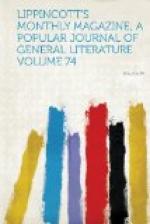One of my windows looked out on olive-gardens and on the old church San Miniato, on the hill of the same name. Mr. Hart, the sculptor, told me that those rooms were very familiar to him. Buchanan Read, I think he said, had occupied them, and the walls in many places bore traces of artist vagaries. There were several nice caricatures penciled among the cheap frescoes of the walls. All the walls are frescoed in Florence. Think of having your ceiling and walls painted in a manner that constantly suggests Michael Angelo!
After some weeks spent in looking at the art-wonders in Florence, I visited many of the studios of our artists. That of Mr. Hart, on the Piazza Independenza, was one of the most interesting. He had two very admirable busts of Henry Clay, and all his visitors, encouraged by his frank manner, criticised his works freely. Most people boldly pass judgment on any work of art, and “understand” Mrs. Browning when she says the Venus de’ Medici “thunders white silence.” I do not. I am sure I never can understand what a thundering silence means, whatever may be its color. These appreciators talked of the “word-painting” of Mrs. Browning.
They sit on their thrones
in a purple sublimity,
And grind down men’s
bones to a pale unanimity.
I suppose this is “word-painting.” I can see the picture also—some kings, and possibly queens, seated on gorgeous thrones, engaged in the festive occupation of grinding bones! Oh, I degrade the subject, do I? Nonsense! The term is a stilted affectation, perhaps never better applied than to Mrs. Browning’s descriptive spasms. Still, she was undoubtedly a poet. She wrote many beautiful subjective poems, but she wrote much that was not poetry, and which suggests only a deranged nervous system. I have a friend who maintains from her writings that she never loved, that she did not know what passion meant. However this may be, the author of the sonnet commencing—
Go from me! Yet I feel
that I shall stand
Henceforward in
thy shadow,
deserves immortality.
But to return to Mr. Hart’s studio. One of the most remarkable things I saw in Florence was this artist’s invention to reduce certain details of sculpture to a mechanical process. This machine at first sight struck me as a queer kind of ancient armor. In brief, the subject is placed in position, when the front part of this armor, set on some kind, of hinge, swings round before him, and the sculptor makes measurements by means of numberless long metal needles, which are so arranged as to run in and touch the subject: A stationary mark is placed where the needle touches, and then I think it is pulled back. So the artist goes on, until some hundreds of measurements are made, if necessary, when the process is finished and the subject is released. How these measurements are made to serve the artist in modeling the statue I cannot very well describe, but




